Leadership Styles: Improving Quality in Saudi Healthcare Sector
VerifiedAdded on 2022/10/31
|10
|1092
|339
Presentation
AI Summary
This presentation provides an overview of different leadership styles—servant, transformational, and transactional—and their impact on quality and safety initiatives within the Saudi Arabian healthcare system. It discusses the pros and cons of each style in relation to quality and safety, highlighting how servant leadership focuses on employee empowerment and patient satisfaction, transformational leadership promotes professional practice and better patient outcomes, and transactional leadership emphasizes compliance through rewards and punishments. The presentation also reflects on the author's leadership style, identifying with transformational leadership due to adaptability, proactive nature, and the ability to encourage others. Furthermore, it examines how these leadership styles influence quality management practices and continuous improvement in Saudi healthcare, concluding that effective leadership is crucial for driving quality improvement initiatives. References to scholarly research articles on the role of leadership in managing quality and safety initiatives in healthcare in Saudi Arabia are also included.

Personal
Leadership Style
Leadership Style
Paraphrase This Document
Need a fresh take? Get an instant paraphrase of this document with our AI Paraphraser

Introduction
• The primary purpose of the presentation is to discuss the
leadership styles
• It will focus on the advantages and disadvantages of
leadership styles in quality and care initiatives
• Leadership styles help leaders to make a plan and set
goals to become an effective leader
• It will focus on the impact of leadership styles on Saudi
healthcare
• The primary purpose of the presentation is to discuss the
leadership styles
• It will focus on the advantages and disadvantages of
leadership styles in quality and care initiatives
• Leadership styles help leaders to make a plan and set
goals to become an effective leader
• It will focus on the impact of leadership styles on Saudi
healthcare
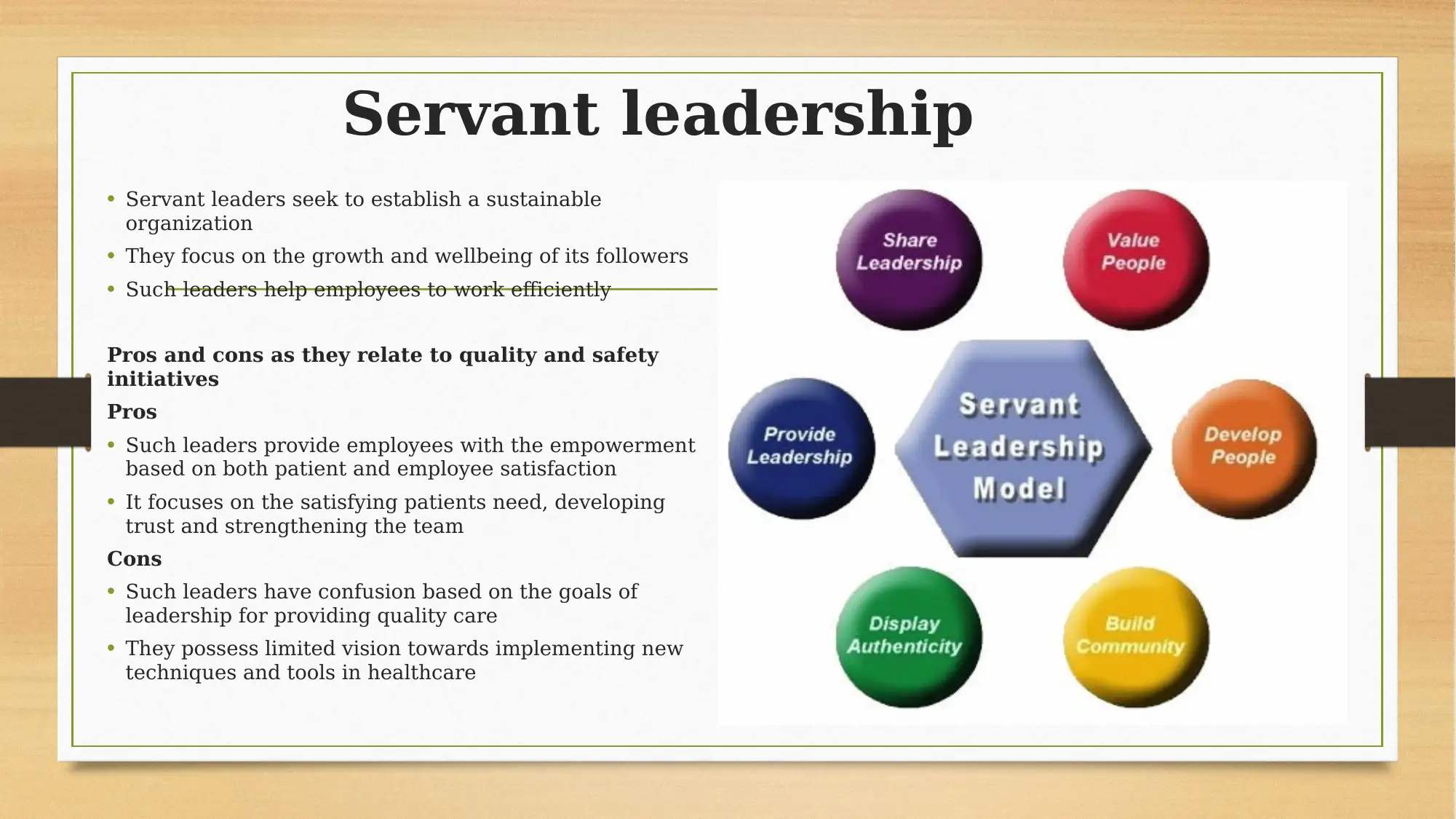
Servant leadership
• Servant leaders seek to establish a sustainable
organization
• They focus on the growth and wellbeing of its followers
• Such leaders help employees to work efficiently
Pros and cons as they relate to quality and safety
initiatives
Pros
• Such leaders provide employees with the empowerment
based on both patient and employee satisfaction
• It focuses on the satisfying patients need, developing
trust and strengthening the team
Cons
• Such leaders have confusion based on the goals of
leadership for providing quality care
• They possess limited vision towards implementing new
techniques and tools in healthcare
• Servant leaders seek to establish a sustainable
organization
• They focus on the growth and wellbeing of its followers
• Such leaders help employees to work efficiently
Pros and cons as they relate to quality and safety
initiatives
Pros
• Such leaders provide employees with the empowerment
based on both patient and employee satisfaction
• It focuses on the satisfying patients need, developing
trust and strengthening the team
Cons
• Such leaders have confusion based on the goals of
leadership for providing quality care
• They possess limited vision towards implementing new
techniques and tools in healthcare
⊘ This is a preview!⊘
Do you want full access?
Subscribe today to unlock all pages.

Trusted by 1+ million students worldwide
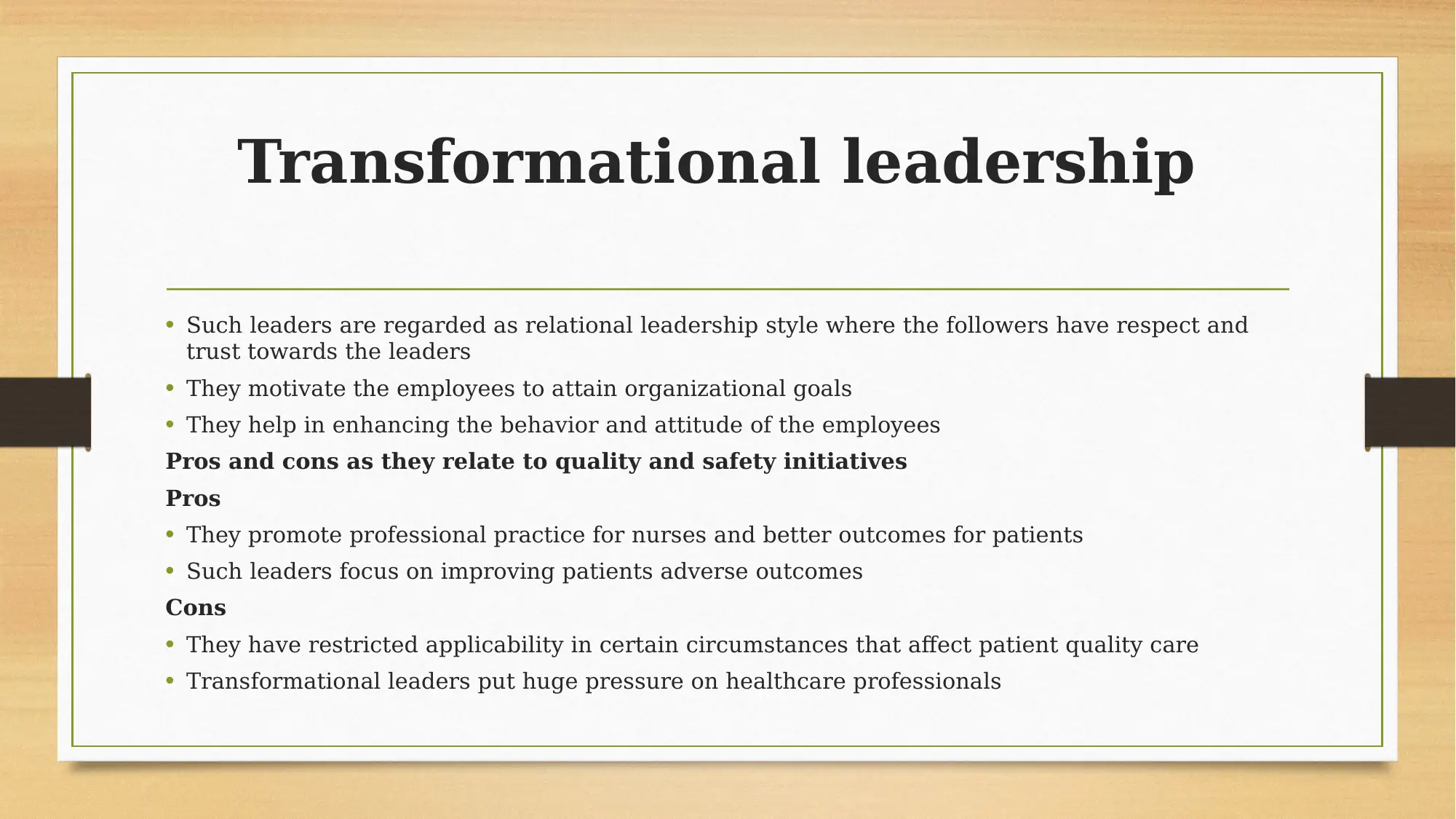
Transformational leadership
• Such leaders are regarded as relational leadership style where the followers have respect and
trust towards the leaders
• They motivate the employees to attain organizational goals
• They help in enhancing the behavior and attitude of the employees
Pros and cons as they relate to quality and safety initiatives
Pros
• They promote professional practice for nurses and better outcomes for patients
• Such leaders focus on improving patients adverse outcomes
Cons
• They have restricted applicability in certain circumstances that affect patient quality care
• Transformational leaders put huge pressure on healthcare professionals
• Such leaders are regarded as relational leadership style where the followers have respect and
trust towards the leaders
• They motivate the employees to attain organizational goals
• They help in enhancing the behavior and attitude of the employees
Pros and cons as they relate to quality and safety initiatives
Pros
• They promote professional practice for nurses and better outcomes for patients
• Such leaders focus on improving patients adverse outcomes
Cons
• They have restricted applicability in certain circumstances that affect patient quality care
• Transformational leaders put huge pressure on healthcare professionals
Paraphrase This Document
Need a fresh take? Get an instant paraphrase of this document with our AI Paraphraser
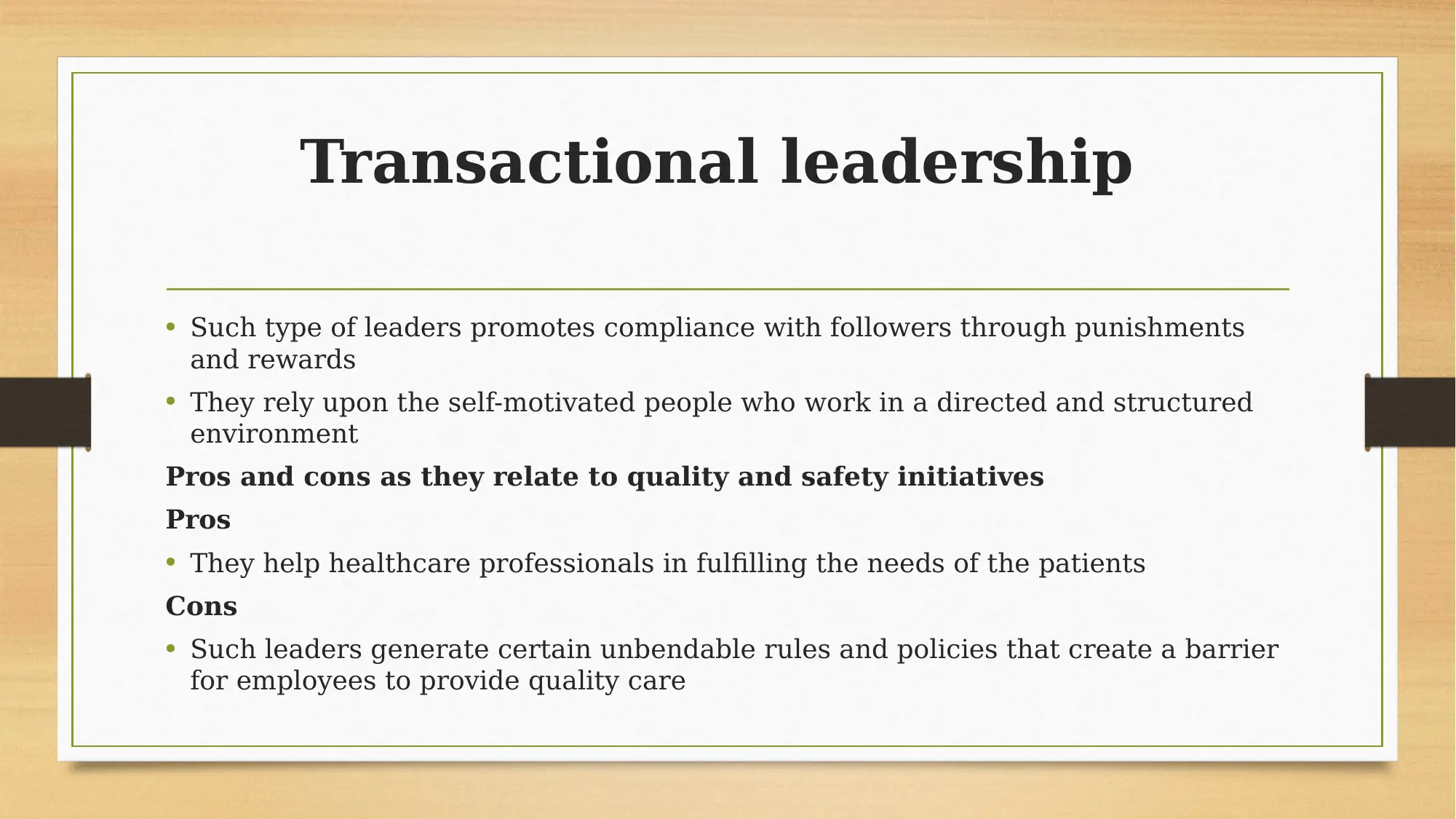
Transactional leadership
• Such type of leaders promotes compliance with followers through punishments
and rewards
• They rely upon the self-motivated people who work in a directed and structured
environment
Pros and cons as they relate to quality and safety initiatives
Pros
• They help healthcare professionals in fulfilling the needs of the patients
Cons
• Such leaders generate certain unbendable rules and policies that create a barrier
for employees to provide quality care
• Such type of leaders promotes compliance with followers through punishments
and rewards
• They rely upon the self-motivated people who work in a directed and structured
environment
Pros and cons as they relate to quality and safety initiatives
Pros
• They help healthcare professionals in fulfilling the needs of the patients
Cons
• Such leaders generate certain unbendable rules and policies that create a barrier
for employees to provide quality care

Style of leadership aligns with
my current leadership style
• My current leadership style is transformational
• The characteristics of such leaders are adaptability,
proactive in nature, ability to take risks
• I have all these characteristics and the ability to
encourage others
• I also retain the following strengths like emotional
intelligence, positive attitude and self-confidence
my current leadership style
• My current leadership style is transformational
• The characteristics of such leaders are adaptability,
proactive in nature, ability to take risks
• I have all these characteristics and the ability to
encourage others
• I also retain the following strengths like emotional
intelligence, positive attitude and self-confidence
⊘ This is a preview!⊘
Do you want full access?
Subscribe today to unlock all pages.

Trusted by 1+ million students worldwide
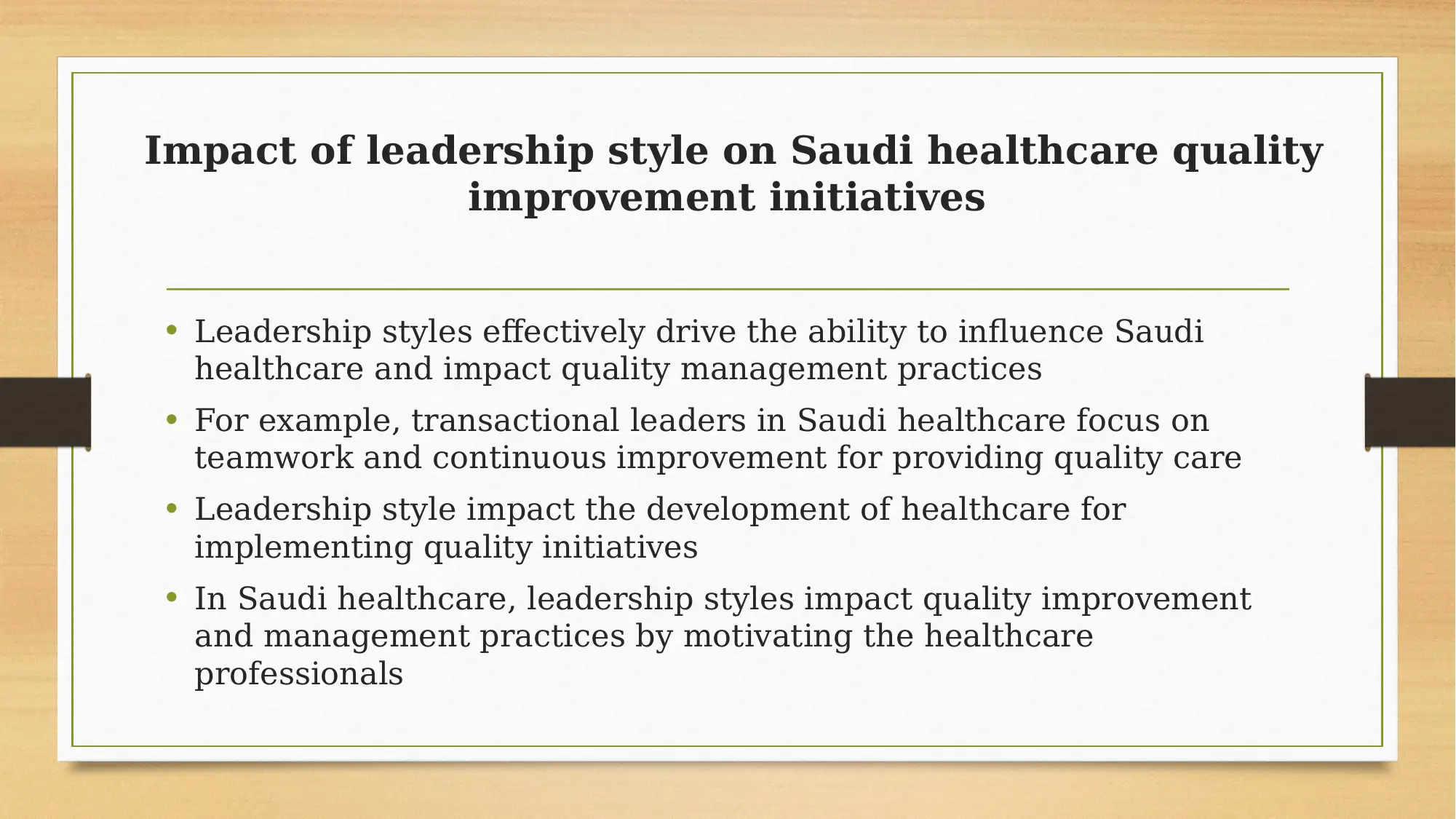
Impact of leadership style on Saudi healthcare quality
improvement initiatives
• Leadership styles effectively drive the ability to influence Saudi
healthcare and impact quality management practices
• For example, transactional leaders in Saudi healthcare focus on
teamwork and continuous improvement for providing quality care
• Leadership style impact the development of healthcare for
implementing quality initiatives
• In Saudi healthcare, leadership styles impact quality improvement
and management practices by motivating the healthcare
professionals
improvement initiatives
• Leadership styles effectively drive the ability to influence Saudi
healthcare and impact quality management practices
• For example, transactional leaders in Saudi healthcare focus on
teamwork and continuous improvement for providing quality care
• Leadership style impact the development of healthcare for
implementing quality initiatives
• In Saudi healthcare, leadership styles impact quality improvement
and management practices by motivating the healthcare
professionals
Paraphrase This Document
Need a fresh take? Get an instant paraphrase of this document with our AI Paraphraser
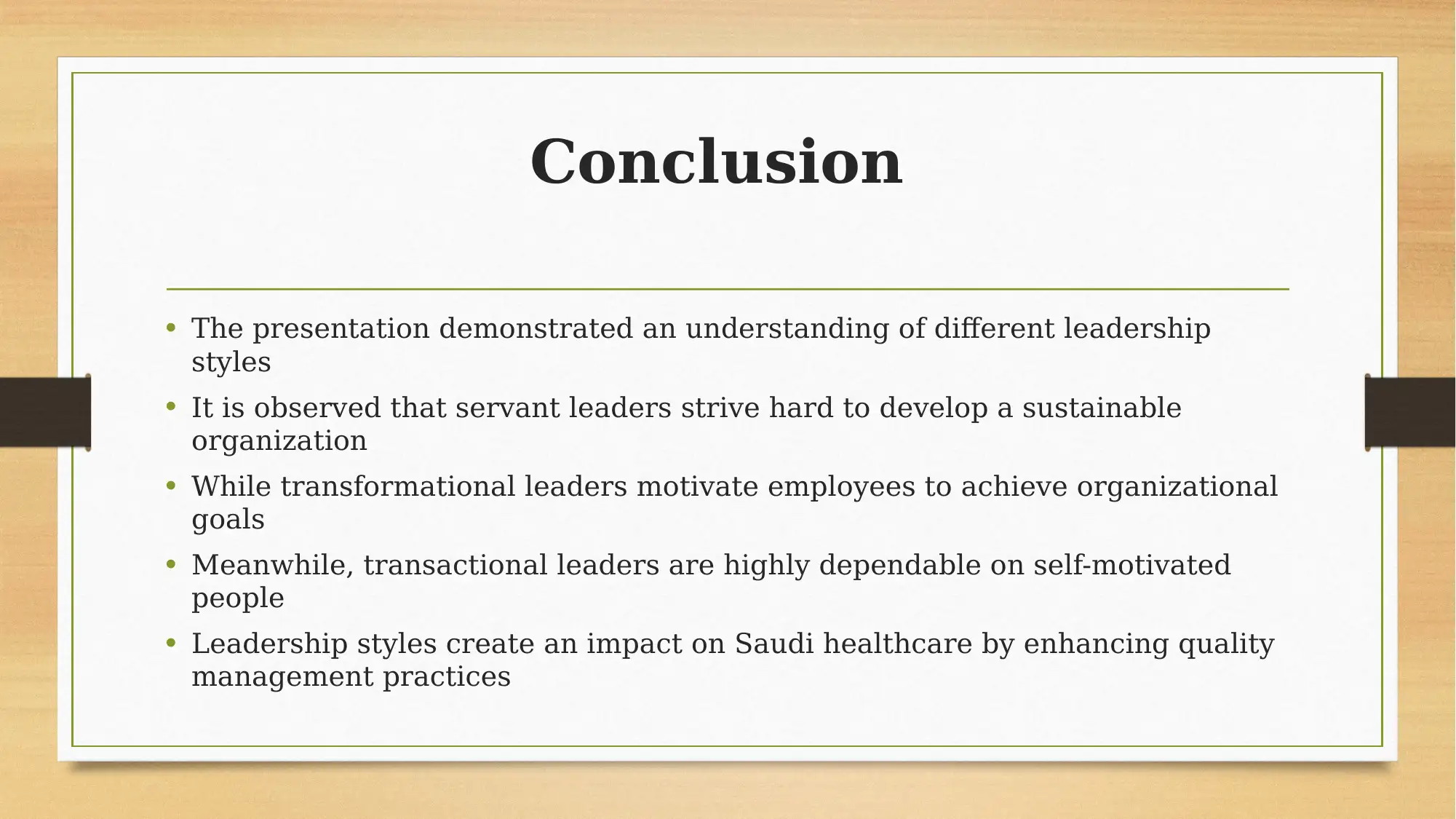
Conclusion
• The presentation demonstrated an understanding of different leadership
styles
• It is observed that servant leaders strive hard to develop a sustainable
organization
• While transformational leaders motivate employees to achieve organizational
goals
• Meanwhile, transactional leaders are highly dependable on self-motivated
people
• Leadership styles create an impact on Saudi healthcare by enhancing quality
management practices
• The presentation demonstrated an understanding of different leadership
styles
• It is observed that servant leaders strive hard to develop a sustainable
organization
• While transformational leaders motivate employees to achieve organizational
goals
• Meanwhile, transactional leaders are highly dependable on self-motivated
people
• Leadership styles create an impact on Saudi healthcare by enhancing quality
management practices
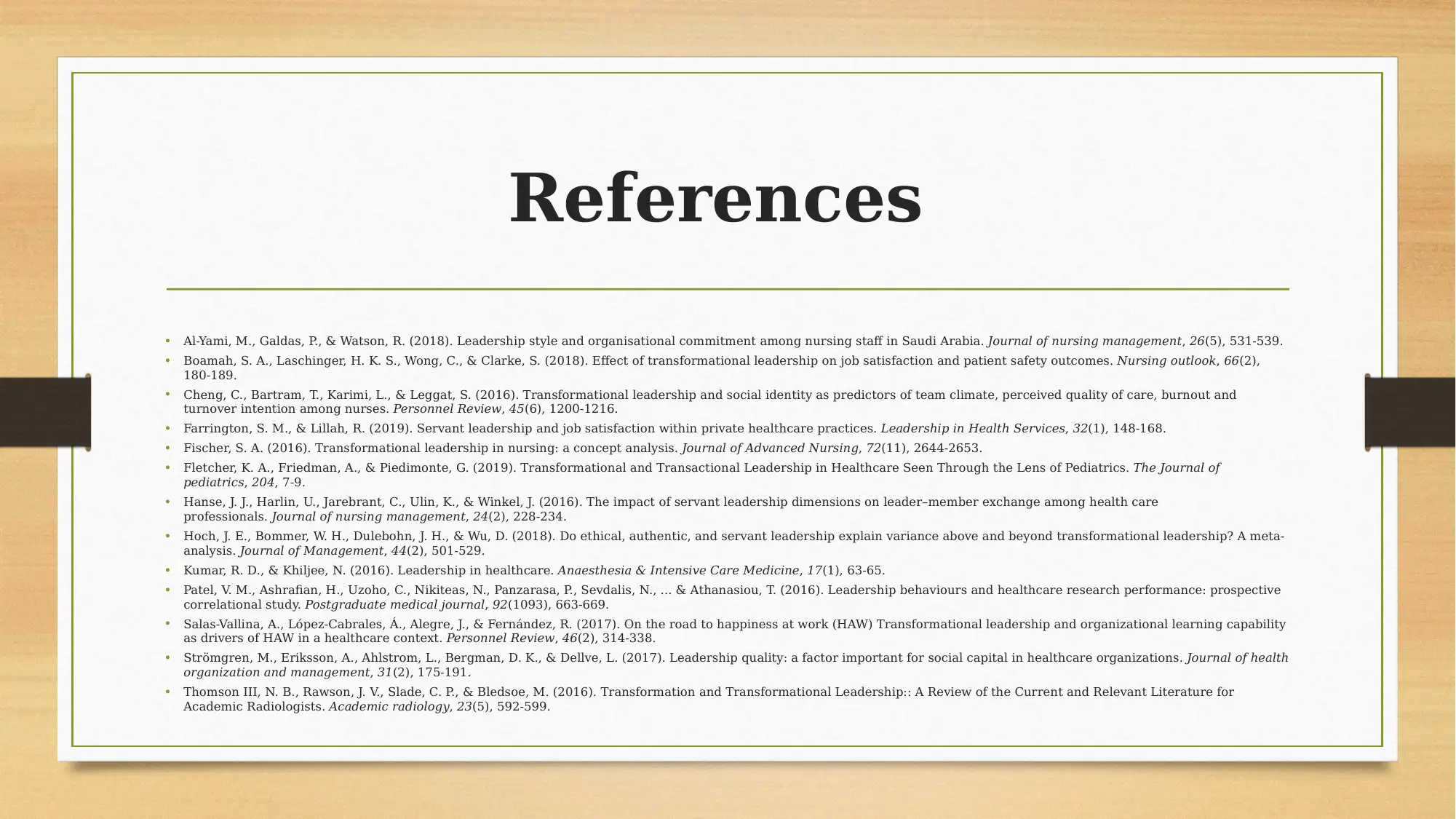
References
• Al‐Yami, M., Galdas, P., & Watson, R. (2018). Leadership style and organisational commitment among nursing staff in Saudi Arabia. Journal of nursing management, 26(5), 531-539.
• Boamah, S. A., Laschinger, H. K. S., Wong, C., & Clarke, S. (2018). Effect of transformational leadership on job satisfaction and patient safety outcomes. Nursing outlook, 66(2),
180-189.
• Cheng, C., Bartram, T., Karimi, L., & Leggat, S. (2016). Transformational leadership and social identity as predictors of team climate, perceived quality of care, burnout and
turnover intention among nurses. Personnel Review, 45(6), 1200-1216.
• Farrington, S. M., & Lillah, R. (2019). Servant leadership and job satisfaction within private healthcare practices. Leadership in Health Services, 32(1), 148-168.
• Fischer, S. A. (2016). Transformational leadership in nursing: a concept analysis. Journal of Advanced Nursing, 72(11), 2644-2653.
• Fletcher, K. A., Friedman, A., & Piedimonte, G. (2019). Transformational and Transactional Leadership in Healthcare Seen Through the Lens of Pediatrics. The Journal of
pediatrics, 204, 7-9.
• Hanse, J. J., Harlin, U., Jarebrant, C., Ulin, K., & Winkel, J. (2016). The impact of servant leadership dimensions on leader–member exchange among health care
professionals. Journal of nursing management, 24(2), 228-234.
• Hoch, J. E., Bommer, W. H., Dulebohn, J. H., & Wu, D. (2018). Do ethical, authentic, and servant leadership explain variance above and beyond transformational leadership? A meta-
analysis. Journal of Management, 44(2), 501-529.
• Kumar, R. D., & Khiljee, N. (2016). Leadership in healthcare. Anaesthesia & Intensive Care Medicine, 17(1), 63-65.
• Patel, V. M., Ashrafian, H., Uzoho, C., Nikiteas, N., Panzarasa, P., Sevdalis, N., ... & Athanasiou, T. (2016). Leadership behaviours and healthcare research performance: prospective
correlational study. Postgraduate medical journal, 92(1093), 663-669.
• Salas-Vallina, A., López-Cabrales, Á., Alegre, J., & Fernández, R. (2017). On the road to happiness at work (HAW) Transformational leadership and organizational learning capability
as drivers of HAW in a healthcare context. Personnel Review, 46(2), 314-338.
• Strömgren, M., Eriksson, A., Ahlstrom, L., Bergman, D. K., & Dellve, L. (2017). Leadership quality: a factor important for social capital in healthcare organizations. Journal of health
organization and management, 31(2), 175-191.
• Thomson III, N. B., Rawson, J. V., Slade, C. P., & Bledsoe, M. (2016). Transformation and Transformational Leadership:: A Review of the Current and Relevant Literature for
Academic Radiologists. Academic radiology, 23(5), 592-599.
• Al‐Yami, M., Galdas, P., & Watson, R. (2018). Leadership style and organisational commitment among nursing staff in Saudi Arabia. Journal of nursing management, 26(5), 531-539.
• Boamah, S. A., Laschinger, H. K. S., Wong, C., & Clarke, S. (2018). Effect of transformational leadership on job satisfaction and patient safety outcomes. Nursing outlook, 66(2),
180-189.
• Cheng, C., Bartram, T., Karimi, L., & Leggat, S. (2016). Transformational leadership and social identity as predictors of team climate, perceived quality of care, burnout and
turnover intention among nurses. Personnel Review, 45(6), 1200-1216.
• Farrington, S. M., & Lillah, R. (2019). Servant leadership and job satisfaction within private healthcare practices. Leadership in Health Services, 32(1), 148-168.
• Fischer, S. A. (2016). Transformational leadership in nursing: a concept analysis. Journal of Advanced Nursing, 72(11), 2644-2653.
• Fletcher, K. A., Friedman, A., & Piedimonte, G. (2019). Transformational and Transactional Leadership in Healthcare Seen Through the Lens of Pediatrics. The Journal of
pediatrics, 204, 7-9.
• Hanse, J. J., Harlin, U., Jarebrant, C., Ulin, K., & Winkel, J. (2016). The impact of servant leadership dimensions on leader–member exchange among health care
professionals. Journal of nursing management, 24(2), 228-234.
• Hoch, J. E., Bommer, W. H., Dulebohn, J. H., & Wu, D. (2018). Do ethical, authentic, and servant leadership explain variance above and beyond transformational leadership? A meta-
analysis. Journal of Management, 44(2), 501-529.
• Kumar, R. D., & Khiljee, N. (2016). Leadership in healthcare. Anaesthesia & Intensive Care Medicine, 17(1), 63-65.
• Patel, V. M., Ashrafian, H., Uzoho, C., Nikiteas, N., Panzarasa, P., Sevdalis, N., ... & Athanasiou, T. (2016). Leadership behaviours and healthcare research performance: prospective
correlational study. Postgraduate medical journal, 92(1093), 663-669.
• Salas-Vallina, A., López-Cabrales, Á., Alegre, J., & Fernández, R. (2017). On the road to happiness at work (HAW) Transformational leadership and organizational learning capability
as drivers of HAW in a healthcare context. Personnel Review, 46(2), 314-338.
• Strömgren, M., Eriksson, A., Ahlstrom, L., Bergman, D. K., & Dellve, L. (2017). Leadership quality: a factor important for social capital in healthcare organizations. Journal of health
organization and management, 31(2), 175-191.
• Thomson III, N. B., Rawson, J. V., Slade, C. P., & Bledsoe, M. (2016). Transformation and Transformational Leadership:: A Review of the Current and Relevant Literature for
Academic Radiologists. Academic radiology, 23(5), 592-599.
⊘ This is a preview!⊘
Do you want full access?
Subscribe today to unlock all pages.

Trusted by 1+ million students worldwide

1 out of 10
Related Documents
Your All-in-One AI-Powered Toolkit for Academic Success.
+13062052269
info@desklib.com
Available 24*7 on WhatsApp / Email
![[object Object]](/_next/static/media/star-bottom.7253800d.svg)
Unlock your academic potential
Copyright © 2020–2025 A2Z Services. All Rights Reserved. Developed and managed by ZUCOL.





